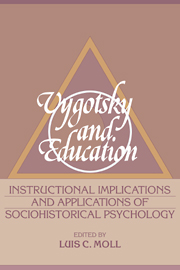Book contents
- Frontmatter
- Contents
- List of contributors
- Preface
- Acknowledgments
- Introduction
- Part I Historical and theoretical issues
- Part II Educational implications
- Part III Instructional applications
- 11 Changes in a teacher's views of interactive comprehension instruction
- 12 Learning to read and write in an inner-city setting: A longitudinal study of community change
- 13 Writing as a social process
- 14 Creating zones of possibilities: Combining social contexts for instruction
- 15 The zone of proximal development as basis for instruction
- 16 Detecting and defining science problems: A study of videomediated lessons
- 17 Assisted performance in writing instruction with learningdisabled students
- Name index
- Subject index
13 - Writing as a social process
Published online by Cambridge University Press: 05 June 2012
- Frontmatter
- Contents
- List of contributors
- Preface
- Acknowledgments
- Introduction
- Part I Historical and theoretical issues
- Part II Educational implications
- Part III Instructional applications
- 11 Changes in a teacher's views of interactive comprehension instruction
- 12 Learning to read and write in an inner-city setting: A longitudinal study of community change
- 13 Writing as a social process
- 14 Creating zones of possibilities: Combining social contexts for instruction
- 15 The zone of proximal development as basis for instruction
- 16 Detecting and defining science problems: A study of videomediated lessons
- 17 Assisted performance in writing instruction with learningdisabled students
- Name index
- Subject index
Summary
Several months after the establishment of a writing program in an after-school daycare program in Chicago, an 8-year-old girl wrote the following story:
Three Little Scarycats
Once upon a time there were
3 little scarycats, there name's
were Manuel, Kevin and Simon. They were
scared of the dark, a cat, a dog, a little
bird, and a little baby. They slept with
their parents because they are to
scard of the dark. They always screamed
when they saw a cat, a dog or a baby
bird. They always started to cry
when they saw a little baby
smile.
This story represents a considerable achievement for both its young author and the adults in charge of the writing program. It illustrates one child's discovery that she can use writing for playful and social purposes of her own devising, and it had an impact on the small community of 16 children and two group workers in the afterschool room when it was read aloud and then dramatized (McLane & Graziano, 1987).
In the course of this informal after-school writing program, children discovered that they could use writing to enhance and extend activities that were already interesting and important to them, such as playing, drawing, and speaking. They could use writing in their play, and they could play with their writing; they could incorporate writing in their drawing, and they could use writing to elaborate on their drawing; they could use writing in their social relationships, to express themselves and to communicate with people who mattered to them.
- Type
- Chapter
- Information
- Vygotsky and EducationInstructional Implications and Applications of Sociohistorical Psychology, pp. 304 - 318Publisher: Cambridge University PressPrint publication year: 1990
- 10
- Cited by

